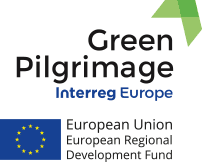Green Pilgrimage
Value of EU Grant - £200,000
Name of funding programme - Interreg Europe
Start and end dates - October 2016 to October 2021
Ancient pilgrim routes such as The Way of St James to Santiago de Compostela, Spain, report an 10% increase in numbers annually, particularly among non-religious groups. Harnessing this increased popularity to protect natural and cultural heritage is a common challenge faced by those responsible for Europe’s major pilgrimage routes. Green Pilgrimage will show policy makers how to protect natural and cultural heritage whilst developing jobs and growth along pilgrim routes by developing low impact tourism, digitalization, pilgrim accommodation and strengthening local traditions. This reconnects pilgrims with their environment, landscape and culture.

- Diocese of Canterbury (UK)
- Norfolk County Council (UK)
- National Institute of Tourism Research and Development (Romania)
- Puglia Region (Italy)
- Trondheim County Authority (Norway)
- Östergötland County Council (Sweden)
Green Pilgrimage will provide an evidence base to regional policy makers. It will show Green Pilgrimage as a social and economically valuable cultural heritage tradition that enhances and develops Europe’s natural landscape and cultural assets.
The best way to protect nature and heritage is to give it economic value in a way that enhances the very heritage that we seek to protect. This requires addressing the different types of policies that impact on natural and cultural heritage.
Our objectives are to:
- integrate pilgrimage objectives into a range of policy types affecting natural and cultural heritage and to evaluate their impact on asset enhancement and protection
- integrate sustainability indicators into policies impacting on natural and cultural heritage
- sustainably develop the economic potential of pilgrimage as seen in the rapid growth of pilgrimage in places like Santiago de Compostela or Walsingham in Norfolk
- develop a broader interpretation of pilgrimage as a journey with meaning; walking for health, for remembrance, for leisure, etc. Wider pilgrimage accessibility increases its potential for heritage development
- promote green pilgrimage ethos as a low carbon socially responsible outdoor activity
- share best practice on pilgrimage route management, promotion and business engagement
- enable stakeholders to benefit from regional expertise
- inform regional policy of project results and outputs
- support a network of pilgrimage places and routes in Europe
- develop Green Pilgrimage action plans that enable the development of natural and cultural assets through sustainable economic growth.
- improved understanding of Green Pilgrimage across partner regions and how they valorise natural and cultural heritage
- best practices analysed and available for trial and transfer between regions
- joint understanding of a range of policies impacting on natural and cultural heritage protection
- improvement of a range of policies impacting our heritage and analyses of how to transfer improvements between policies
- ability to measure economic benefits and sustainability of best practices identified
- improved understanding of smart specialisation innovations for pilgrimage routes
- stakeholder understanding of a range of growth policies and how they impact natural and cultural heritage
- increase in European pilgrimage numbers of all faiths and none and across ethnicities and age groups
- increased value for pilgrimage tourism providing inward investment to natural and cultural heritage assets
- growth policies that both develop and protect natural and cultural heritage.
- increased economic value to the major pilgrimage and long distance assets in Kent e.g. North Downs Way, Pilgrims Way, Canterbury Cathedral, St Augustine’s Way, Via Francigena
- increased awareness of the potential of pilgrimage related tourism for Kent businesses
- increased knowledge of pilgrimage and long distance walking growth for Kent policy makers and tourism organisations
- evidence base to enable further funding to improve pilgrimage and long distance walking infrastructure.